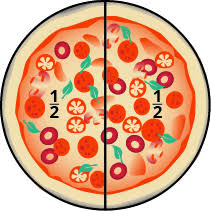Activities for Week 3
Activity W 3.1 Understanding Denseness of Fractions
Objective:
To understand that there are endless fractions between any two given fractions.
Through this activity, students will get an idea about the denseness of fractions.
That is, they will be able to know that they can find as many fractions as possible between any two fractions.
This activity will also help to improve number sense and reasoning skills with fractions.
Material Required
Long rolls of paper strips
Scissors
NCERT Mathematical kits (if present in school)
Blank cards
Procedure
Step 1
Write two fractions, say, 1/4 and 1/2 on the board and the students may be asked to check, if there are fractions between them.
Discuss that denseness of fractions means that there can be as many fractions as we want between the two fractions.
Step 2:
Hands-on Exploration
Take two copies of a paper strip
Ask the students to fold those strips in 2 equal halves.
Take one of the strips and cut it into two equal parts with the help of scissors.
Take one part and keep it on the other strip.
Take the remaining half and put it on the first half.
Continue this process until the students are unable to cut remaining part in to 2 equal parts
Discussion to Explore
ANSWER:
2. Can we divide these strips further more? If yes, then to what extent?
Yes, we can keep dividing the strip into smaller and smaller pieces endlessly — in theory, we can keep cutting the parts infinitely, because between any two fractions, there is always another fraction.
So, the half of 1/2 is 1/4.
ANSWER:
1/4 is greater than 0 but less than 1/2, so it lies between 0 and 1/2 on the number line.
ANSWER:
No matter how close two fractions are, there will always be more fractions between them.
6. Ask students, if they see gaps between their fractions.
ANSWER:
Yes, students will observe gaps between fractions on the strip or number line, which shows there is always room for another fraction in between.
7. Challenge: “Is there another fraction that can go between these parts of strips?”
ANSWER:
Yes! Always.
For example, between 1/4 and 1/2, you can find:
And between 1/4 and 3/8, you can again find:
And so on... endlessly!
Extension
A simple formula to find a fraction between two given fractions:
This gives a new fraction that lies exactly between the two.
You can also practice this on a number line or using the Math Kit for better understanding!
Conclusion:
Through this activity, I learned that fractions are dense. This means that between any two fractions, there are infinite fractions. No matter how close two fractions are, we can always find another fraction between them by using the formula:
This activity helped me understand that fractions can be divided into smaller and smaller parts, and there is no end to the number of fractions that can exist between any two numbers. Using strips, number lines, or the Math Kit makes this concept easier and fun to learn!














